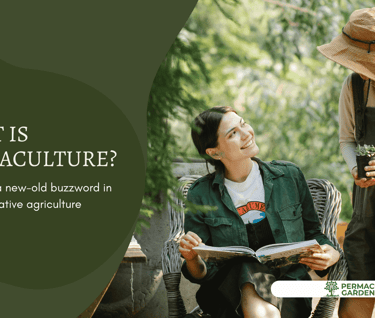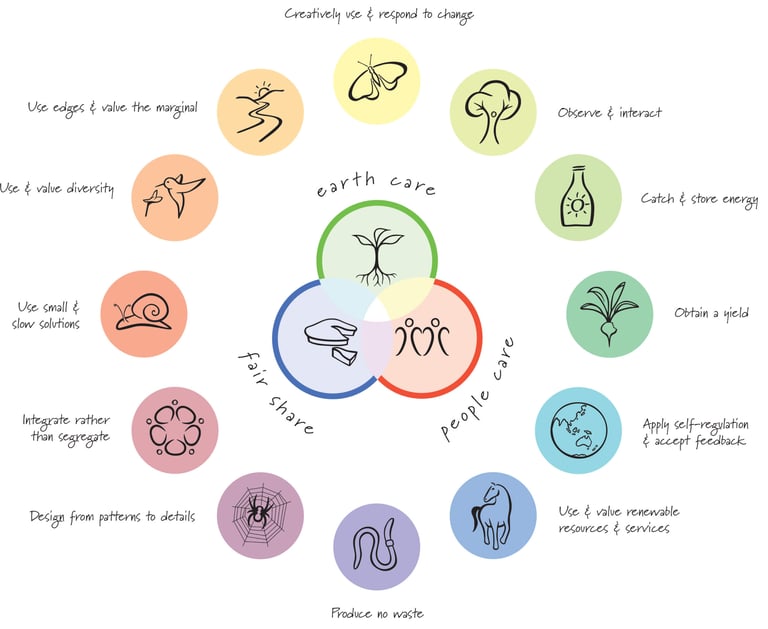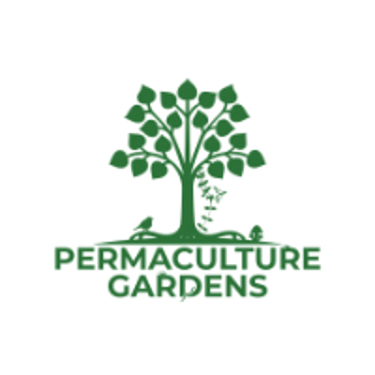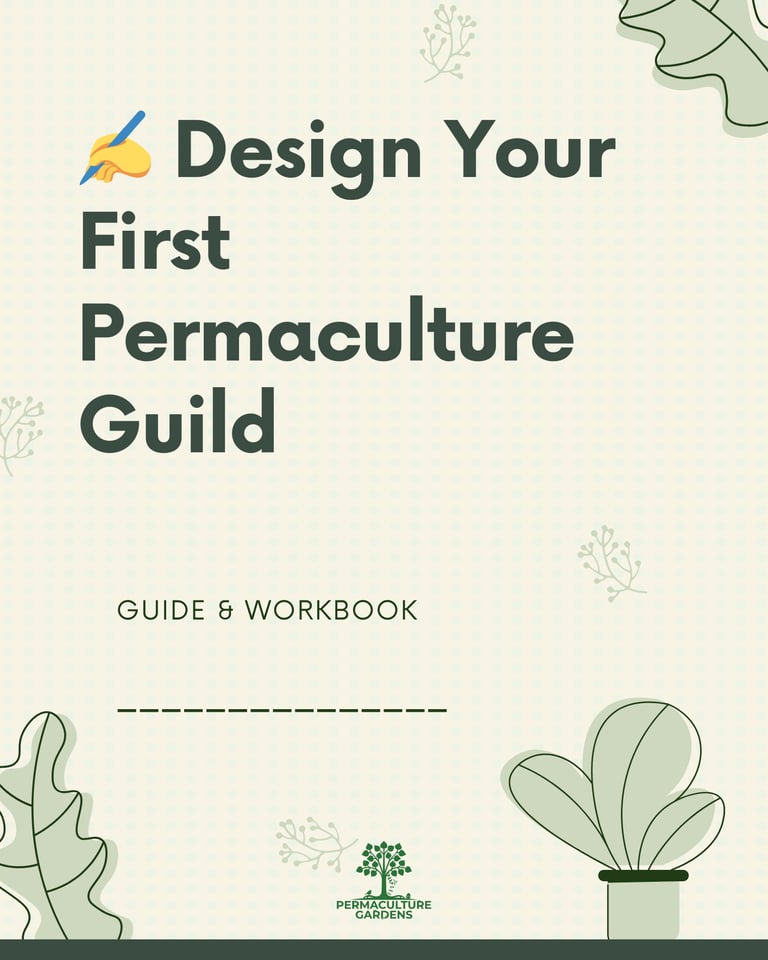What is Permaculture?
Ever asked the question: What is permaculture? In this blog, we have the comprehensive and concise definitions that you've been looking for!
4/15/20238 min read


Disclaimer: This What is Permaculture article contains some affiliate links. The small commission we receive if you choose to purchase goes towards making this gardening education available for free! We do not affiliate for anything we do not personally use. Thanks so much for your support!
Definition (What is Permaculture?)
Analogy & Comparison
Ethics
Principles
Permaculture has become a buzzword in recent years due to a growing interest in sustainable and regenerative agriculture.
Bill Mollison (who has come to be known as the Father of Permaculture) and his student David Holmgren were the first to coin the term "permaculture" from the concept of a "permanent agriculture."
As the years went on, permaculture encompassed more than just agriculture. We hope this article will help you understand what permaculture is by approaching the question, "What is permaculture?" in four ways:
What is Permaculture?
When asked to define permaculture, Bill Mollison once gave a very broad yet simple meaning:
"Permaculture is a set of permanent systems for persistent human existence."
His more official definition published in the book, "Introduction to Permaculture," reads:
"Permaculture is a philosophy of working with, rather than against nature;
of protracted and thoughtful observation rather than protracted and thoughtless labor;
and of looking at plants and animals in all their functions, rather than treating any area as a single-product system."
Courtesy of DogGoWoof Productions
Please consider supporting the production of their permaculture film.

View the video below to listen to a concise summary of permaculture from its originators.
1. Defining Permaculture
Permaculture: A Design System
Another student of Mollison's, Geoff Lawton explicitly, highlights the design and holistic features of permaculture in his definition. According to Lawton:
Permaculture is a design system for ecological and sustainable living, integrating plants, animals, people, buildings, and communities.
There is nothing wrong with having several definitions, as long as you understand the core principles, the ethics, and the applications of permaculture. The features that you value about permaculture will inevitably become a part of your own definition.
NetworkEarth.org relates how the Texas Department of Agriculture once asked Mollison to consult on sustainability. He then proceeded to ask the officials what exactly their definition of sustainability was in the first place.
Lo and behold, they could not answer him.
Mollison proceeded to explain that for him, a sustainable system was any system that in its lifetime, had an output that far exceeded the system's input.
So in a sense, if we were to draw that out, the output of your system should be greater than your input.
SUSTAINABILITY DEFINED
Small input,
Big output
So in a sense, if we were to draw that out, the output of your system should be greater than your input.
But permaculture is not merely a linear system.


In the video below, we are introduced to the concept of the "Story of Stuff" by Greenpeace director, Annie Leonard.
2. Defining Permaculture through Analogy and Comparison
Linear Systems vs. Cyclical Systems

The Story of Stuff demonstrates how linear systems create products that are uni-directional. Fossil fuels are extracted from the earth to produce these products that end up in the landfill.
Permaculture design is a cyclical if not, spiral system, where the end products are the main ingredients to create a brand-new product (food, clothing, medicine). The term "regenerative agriculture" is often used synonymously with permaculture to mean that the creation of food is within a closed loop. The end products and bi-products are used to regenerate new growth.
That is not what conventional agriculture currently does.
Modern-day agriculture, and even some organic agricultural practices, are linear.
At the end of the system, we dispose of our food waste in landfills instead of cycling them back into our gardening systems.
Permaculture is different from organic gardening because
Permaculture is always a "cyclical" system that aims to return to the earth that which was taken from it. Organic gardening can be cyclical or linear.
If we view agricultural systems in the light of whether or not they are linear or cyclical, we can see that some organic gardening practices can still be linear
A linear organic gardening example would be carrots grown without pesticides but using groundwater aquifers that are not replenished as fast as they are depleted. Thus, in this system, you end up with organic carrots, but you dry up aquifers in the process.
Permaculture is not just about gardening. It is about the relationships that help societies thrive. Its principles (some of which are mentioned below) are applied to music, business, finance, education, community management, homes, gardens, and a host of other things.
And that is why from Geoff Lawton's definition above, permaculture may seem to be a cycle, a design system for ecological and sustainable living, integrating plants, animals, buildings, people, and communities.
How is Permaculture Different from Organic Gardening?
The terms Permaculture and Regenerative Agriculture often get used interchangeably. It is common to hear both terms used synonymously when talking about fertility, soil restoration, biodiversity, and no-till methods of growing food.
This is not surprising given the fact that both of them have myriad definitions. As the researchers concluded in a University of Colorado Boulder study entitled, "What Is Regenerative Agriculture? A Review of Scholar and Practitioner Definitions Based on Processes and Outcomes"
"Whether and how regenerative agriculture is defined has consequences for how this form of food production is perceived by a variety of stakeholders, including policy-makers and consumers. Given the diverse range of ways in which the term “regenerative agriculture” has been defined and described, we suggest that users of the term define it carefully for any given use and context."
Permaculture and Regenerative Agriculture differ according to their definitions. Some regenerative agriculturalists do not think the processes by which soil fertility is achieved are as important as there is fertility in the end.
Dr. Jake Mowrer, associate professor, and extension specialist at the Texas A&M University Department of Soil and Crop Sciences, echoes the conclusions of the study above by saying,
"The recommended practices for regenerative agriculture boil down to "Do no harm," but many of the instructions are quite vague such as "Improve the land," "Revitalize the soil," and “Be dynamic and holistic.” However, other recommendations are more clear: Reduce tillage, Use cover crops, Practice crop rotation, and Apply compost."
We can thus infer that Permaculture and Regenerative Agriculture intersect along the lines of agricultural methods and processes. However, permaculture differs in that:
Permaculture goes beyond the scope of agriculture and applies to different disciplines.
As the originators saw it, permaculture was a closed-loop/ cyclical system. Regenerative Agriculture is not necessarily so.
How is Permaculture Different from Regenerative Agriculture?
Even though permaculture is often thought of as a closed-loop or cyclical system, it is much better represented as a spiral system because its aim is by design and observation to improve upon a system with each passing season or year.
You improve your garden process, you produce more yield, you create more compost, and in turn, you build more soil.
Your system gets better and better over time. And this is due in part to one of the core principles of Permaculture being able to observe and act upon that observation.
But before we talk about Permaculture Principles, another thing that makes permaculture different from organic gardening or Regenerative Agriculture is that it is based on three ethics. What are ethics?
Permaculture as a Cycle or a Spiral
Ethics are universally agreed-upon norms of what the right thing to do is. In permaculture, these ethics are:
Earth Care
People Care
Fair Share
3. Permaculture Ethics


Whatever methods we use to pursue a yield, whether that yield is agricultural or not, should consider the preservation and stewardship of the earth. In permaculture, if we take water from an aquifer, we would replenish the water. We can create ponds and more water-catchment systems in our agricultural lands to provide water for growing food.
In the end, caring for the earth will, in turn, take care of the second ethic, which is to take care of people.


We never exploit the farmworkers. People are never just a means towards the creation of an end product. Because of permaculture, they would live richer lives.
Human relationships, just like the relationships of the elements in a garden are at the heart of People Care.
This ethic is where the community comes in and plays a huge role in living out the fullness of permaculture. In essence, not only do we pay farmworkers a fair wage, but we also give them a fair share of what they grow.


The third ethic, Fair Share, is one where we share the abundance generously. In an ideal system, farm laborers would have the first dibs of the crops because they would have ownership of that farm. And would distribute the harvest equitably to those in need.
Earth Care
People Care
Fair Share
The final thing that makes permaculture different from organic gardening or Regenerative Agriculture is that it has evolved, and continues to evolve with certain principles.
Permaculturists (those who practice permaculture) practice these principles or universals throughout the world. These principles are not bound by place, time, or circumstance. As we continue to use and develop permaculture methodologies and designs, we may discover even more principles.
4. Permaculture Principles
Permaculture's co-creator, David Holmgren codified the following first twelve:
Observe and Interact
Catch and Store Energy
Obtain A Yield
Apply Self-Regulation and Accept Feedback
Use and Value Renewable Resources and Services
Produce no waste
Design from Patterns to Details
Integrate Rather than Segregate
Use Small and Slow Solutions
Use and Value Diversity
Use Edges and Value the Marginal
Creatively Use and Respond to Change
Image courtesy of https://permacultureprinciples.com/principles/


CONCLUSION
What does Permaculture mean to you?
There are so many facets to permaculture that sometimes one definition isn't enough to capture its essence.


On the last day of my Permaculture Design Course (PDC), Wayne Weiseman, my teacher asked the class this same question, "What is permaculture?" Each student was asked to come up with his or her definition and internalize it.
For me, certain aspects unique to permaculture always stand out. One is that the very idea of permaculture comes to us in the shape of a pattern. And that pattern is a spiral.
Another highlight for me is that permaculture is a design system based on observation. Words like whole systems thinking, design, and observation are what make permaculture more than merely a method.
Although permaculture at its core is universal, each application is unique to its location, climate, and culture. Because it is such a massive concept, our understanding of it will vary and may change based on our experience.
There are other regenerative/sustainable designers out there who don't call themselves permaculturists but certainly are.
Some of them like Austrian farmer, Sepp Holzer derived his own version of permaculture quite separately from Bill Mollison, and yet Mollison himself recognized his way of designing systems as permaculture.
Permaculture was never intended to be a cookie-cutter template for mass consumption. It was meant to be a core of ethical principles to be used as a basis for producing food, medicine, livelihood, and novel ways to sustainably support human life.

We've given a webinar on the meaning of permaculture in the past. Unfortunately, we were unable to record the entire webinar.
Click the video below to view the tail-end of that webinar.
Dig Deeper
Ready to grow an abundant garden?
Start with your first permaculture guild!
🎁 Download my free Guide + Worbook:
"Design Your First Permaculture Guild"
– A simple, printable PDF to create a thriving mini-ecosystem at home 🌸
Permaculture Gardens - your online resource for organic & sustainable gardens.
Contact
permaculturegardens@gmail.com
Bethany Farm
41558 Stumptown Rd.,
Leesburg, VA 20176


